Rediscover traditional craftsmanship with these seven DIY heritage mold patterns: Victorian Floral with embossed roses, Traditional Celtic Knot wooden frame, Heritage Farmhouse slab with dividers, Colonial-Era honeycomb silicone design, William Morris botanical impressions, Vintage Apothecary label stamps, and Rustic Tartan-patterned loaf molds. You'll create authentic, artisanal soaps that honor historical techniques while adding unique character to your homemade products. These patterns blend timeless aesthetics with modern functionality for truly special creations.
Victorian Floral Soap Mold With Embossed Roses
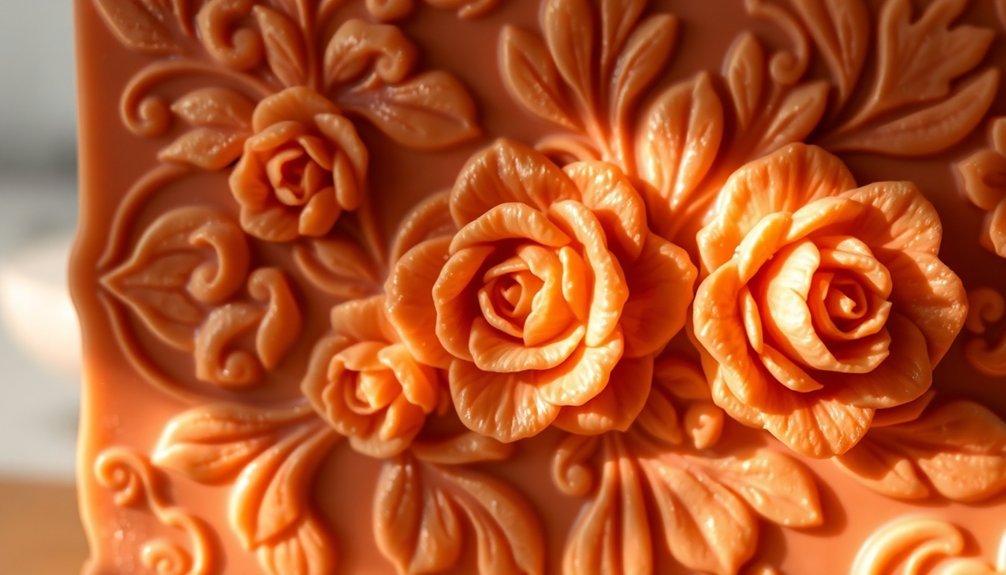
Elegance defines the Victorian floral soap mold with its intricate embossed roses.
Drawing inspiration from the ornate Victorian era, these molds blend Art Nouveau influences with traditional styling to create soaps that don't just cleanse but delight the senses.
Beauty transcends utility when Victorian elegance and Art Nouveau flourishes transform everyday cleansing into sensory poetry.
You'll appreciate the silicone construction that offers heat resistance and easy release properties. These high-quality molds feature premium silicone that ensures long-lasting performance through multiple uses.
When you're ready to unmold your creation, a quick trip to the freezer or a warm water bath will help separate your soap cleanly. The non-stick surface guarantees your detailed roses emerge perfectly formed.
For best results, maintain your mold with gentle cleaning and proper storage in a dry area.
The durability means you'll craft countless batches of gift-worthy soaps that capture both Victorian charm and modern craftsmanship.
Traditional Celtic Knot Wooden Soap Frame
Timeless and mystical, the Traditional Celtic Knot Wooden Soap Frame brings ancient symbolism to your modern soap-making endeavors. Crafted with precision, these wooden frames showcase the intricate interlocking patterns that represent eternity and interconnectedness in Celtic culture. These designs perfectly complement artisan crafted soaps like those featuring oatmeal, milk and honey with Celtic motifs.
You'll find these frames available in various wood types, including oak, maple, and cedar, each offering unique characteristics that can complement your handmade soaps. The detailed craftsmanship creates a distinctive impression on your soap products that attracts customers seeking artisanal quality.
- Hand-carved details require skilled woodworking techniques for precise pattern transfer
- Creates elegant, Old World charm that elevates ordinary soap bars
- Can be customized with different wood stains to match your brand aesthetic
- Functional design allows for easy demolding while providing beautiful results
Heritage Farmhouse Slab Mold With Dividers
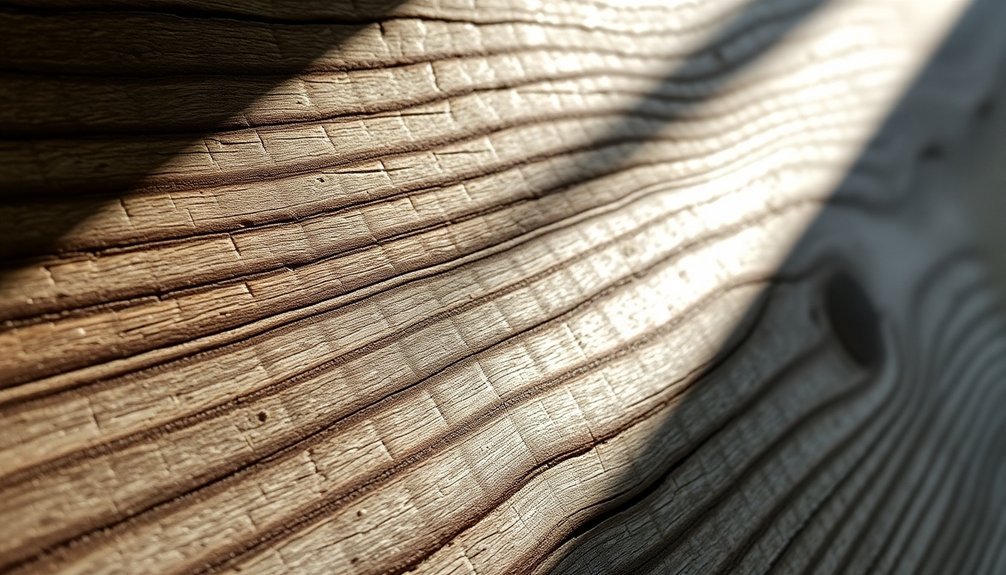
The Heritage Farmhouse Slab Mold with its meticulous divisional design captures the essence of traditional artisan soap-making while preserving historical aesthetics.
You'll find the multi-chamber configuration offers both functional efficiency and a nod to generations-old preservation techniques used by rural craftspeople.
The removable wooden dividers not only create uniform bars but also reflect the careful craftsmanship that farmhouse artisans valued for creating consistent, high-quality products for family use and local trade. The ease of removal for these dividers provides a significant production advantage, allowing for smooth unmolding and minimizing damage to your finished soap bars.
Historic Divisional Aesthetics
Historic divisional aesthetics in heritage slab molds reflect a perfect marriage of form and function that's endured for generations.
When you recreate these traditional designs, you're connecting with soapmaking practices that value both practicality and visual harmony. The dividers that create uniform bars aren't just practical—they represent a cultural commitment to craftsmanship. Modern versions produce standard soap bars measuring 2 1/2 x 3 1/2 inches, maintaining traditional proportions.
- Wooden dividers with hand-carved details create rustic bars reminiscent of 19th-century farmhouse soaps
- Metal inserts with geometric patterns offer precision while echoing Victorian industrial design
- Adjustable spacing systems allow for traditional 3-inch square bars or narrower colonial-style rectangles
- Beveled edges on dividers produce the characteristic rounded tops seen in heritage soap collections
These aesthetic elements transform functional molds into vessels of cultural preservation, allowing you to create authentic heritage soaps.
Multi-Chamber Preservation Techniques
Multi-chamber preservation techniques represent a sophisticated advancement in heritage soapmaking, building directly upon traditional divisional aesthetics.
When you're creating these molds, you'll need to select materials that authentically mimic historical construction patterns, such as oak or pine for the framework and traditional lime plaster for casting.
The divisible design of these molds allows you to remove sections easily, giving you better access during the preservation process.
You'll find that slab mold dividers are essential for maintaining precise chamber dimensions and structural integrity.
For more intricate patterns, consider utilizing 3D scanning and laser cutting to achieve the precision required for historical accuracy.
While material degradation and environmental factors present challenges, the benefits include sustainability, cultural heritage preservation, and educational value that showcases historical construction techniques.
Understanding the aging and failure of building materials will help you select appropriate resources for your heritage mold construction.
Colonial-Era Honeycomb Pattern Silicone Design
Reviving colonial-era craftsmanship, today's silicone honeycomb pattern molds let you create historically authentic designs with modern convenience.
You'll find these versatile molds perfect for moisture-resistant applications in bathrooms, kitchens, and outdoor living spaces where traditional materials would deteriorate. With a heat resistance of up to 450F, these molds maintain their integrity even in high-temperature environments.
The honeycomb pattern's architectural heritage adds both visual interest and practical functionality to your heritage-inspired projects.
Colonial Craftsmanship Revival
The resurgence of colonial-era honeycomb patterns in modern silicone molds represents a fascinating bridge between America's craft heritage and contemporary DIY culture.
You'll find these traditional designs gaining popularity as artisans and hobbyists seek authentic connections to historical craftsmanship methods.
- Premium silicone materials offer durability while honoring the intricate patterns that once adorned colonial-era textiles and home decorations.
- Creating honeycomb-patterned candles, soaps, and confections lets you incorporate symbolism of diligence and resourcefulness valued by early American settlers.
- The versatility of these molds enables you to experiment with various colors, fragrances, and materials while maintaining historical authenticity. These quality molds work perfectly with various wax types, including paraffin, soy, and beeswax, making them accessible for beginners and professionals alike.
- Your finished creations serve as conversation pieces that celebrate America's crafting heritage while functioning as practical household items.
Moisture-Resistant Heritage Applications
When preserved with silicone-based heritage molds, colonial-era honeycomb patterns offer remarkable moisture resistance that addresses a critical challenge in historical preservation.
You'll find these patterns particularly effective in older structures where natural settling has created water infiltration points.
The honeycomb design creates multiple small barriers that prevent moisture penetration while maintaining period-appropriate aesthetics.
By applying this silicone treatment to porous historical materials, you're establishing a protective barrier that keeps substrate moisture content below the critical 20% threshold needed for mold growth.
Unlike modern synthetic solutions that clash with authentic appearances, these heritage patterns work with your building's character while providing contemporary protection.
They're especially valuable in areas with poor ventilation or where installing modern HVAC systems would compromise historical integrity. Implementing these patterns is most successful when combined with adequate air movement to inhibit moisture retention in the substrate.
William Morris Inspired Botanical Impression Mold
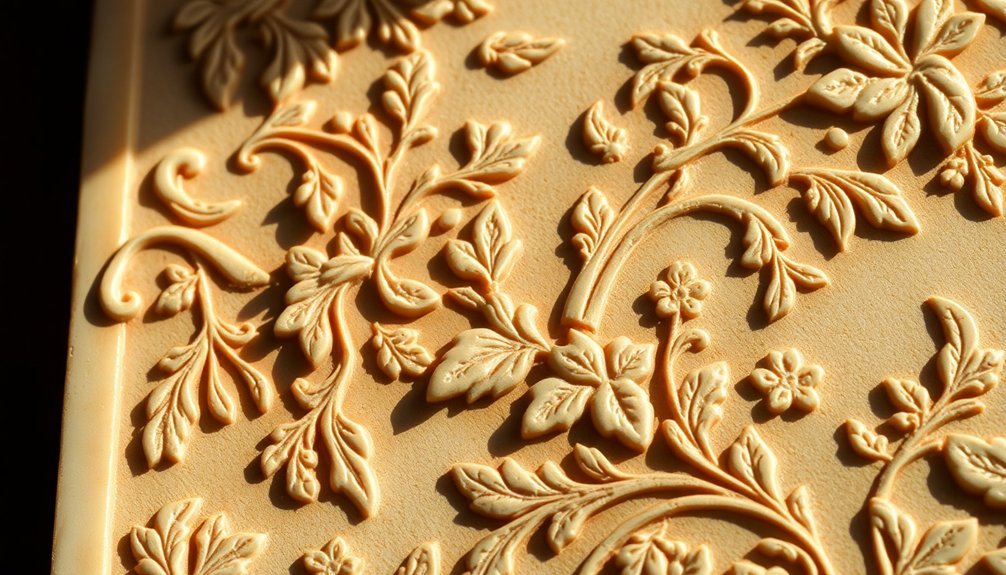
Intricate botanical patterns from William Morris's revolutionary designs offer perfect inspiration for creating heritage mold patterns that capture nature's essence.
By studying his naturalistic yet stylized interpretations of plant forms, you'll create molds that honor the Arts and Crafts movement while adding historical depth to your projects. Morris viewed wallpaper as a makeshift decoration and preferred woven textile hangings for his own home.
- Use interwoven floral motifs and scrolling foliage to achieve the complex layering found in classics like "Larkspur" and "Jasmine"
- Incorporate British garden elements that Morris observed, ensuring designs are stylized yet botanically accurate
- Create woodblock-inspired textures that mimic the original printing techniques Morris pioneered
- Select materials that complement the muted, natural color palette typical of Morris's wallpaper innovations
Your finished molds will work beautifully for pottery, soap making, or decorative plaster elements.
Vintage Apothecary Label Stamp for Soap Bars
Creating authentic vintage apothecary label stamps transforms ordinary soap bars into artisanal treasures with historical charm. You'll find these stamps particularly effective at craft fairs and markets where unique packaging helps your products stand out.
Choose designs that incorporate botanical themes and classic typography reminiscent of old medicine labels. Earthy tones and sepia inks enhance the vintage appeal while kraft paper backgrounds provide the perfect canvas. You can customize these elements to align perfectly with your brand identity.
Unlike alternatives, apothecary stamps greatly improve customer perception through their attention to detail and craftsmanship. For best stamping results, wait until your soap is 2-3 weeks old to apply your vintage designs. When coordinated with your soap molds, they create a cohesive product presentation that customers value.
Digital tools make it easy to iterate designs before committing to final stamps for production.
Rustic Tartan-Patterned Loaf Mold With Liner
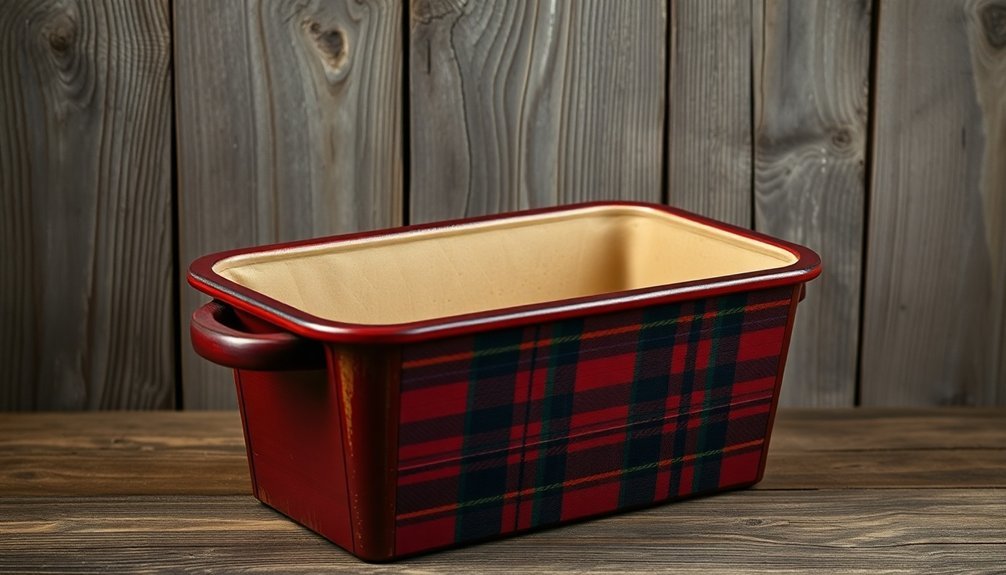
Rustic tartan-patterned loaf molds with liners blend traditional Scottish heritage with modern soap-making functionality.
These molds combine woodworking craftsmanship with practical silicone liners that resist high temperatures and release soap easily. You'll need basic woodworking skills to create the outer frame, while the silicone liner guarantees your soaps unmold without damage. The silicone interior can withstand temperatures up to 500ºF, making it perfect for both cold process and hot process soap making.
- Wood exterior provides rustic charm while silicone interior offers practical durability and easy release
- Compatible with both cold process and melt-and-pour soap making techniques
- Customizable tartan patterns can reflect family heritage or seasonal themes
- Creates professional-looking bars that stand out in craft markets with their distinctive cultural design
The finished mold serves as both a functional tool and a celebration of traditional patterns, elevating your soap-making projects beyond ordinary designs.
Frequently Asked Questions
Can Beginners Use Heritage Molds Without Specialized Equipment?
Yes, you can use heritage molds as a beginner without specialized equipment. You'll only need basic soap-making tools like stick blenders, spatulas, measuring tools, protective gear, and a clean workspace for successful results.
How Do You Prevent Soap From Sticking to Wooden Molds?
Line your wooden molds with parchment paper or silicone sheets. You'll also benefit from applying mineral oil or wax to exposed wood surfaces. Freezing your soap briefly before unmolding helps release it cleanly.
What Oils Best Complement the Historical Aesthetic of Heritage Patterns?
For historical aesthetics in wooden molds, you'll find linseed and tung oils most authentic. They enhance wood grain while providing protection. Walnut oil delivers a richer, deeper tone if you're seeking a traditional appearance.
Are Heritage Mold Patterns Suitable for Commercial Soap Production?
Heritage mold patterns can work for small-scale commercial production, but you'll face durability challenges with large batches. Consider HDPE or wooden alternatives for high-volume soap making while maintaining those distinctive design elements you love.
How Can I Customize Heritage Molds for Seasonal or Themed Collections?
You can customize heritage molds for seasonal collections by adapting colors, adding theme-specific textures, modifying shapes, or incorporating seasonal motifs. Try 3D printing for complex designs or using silicone for intricate details.
In Summary
You've now got seven historical mold options that'll breathe new life into your soap crafting. Whether you're drawn to Victorian elegance, Celtic tradition, or farmhouse simplicity, these heritage designs connect your creations to time-honored patterns. Don't hesitate to adapt these designs with your personal touch. With these molds in your workshop, you're not just making soap—you're preserving artistic traditions with every pour.

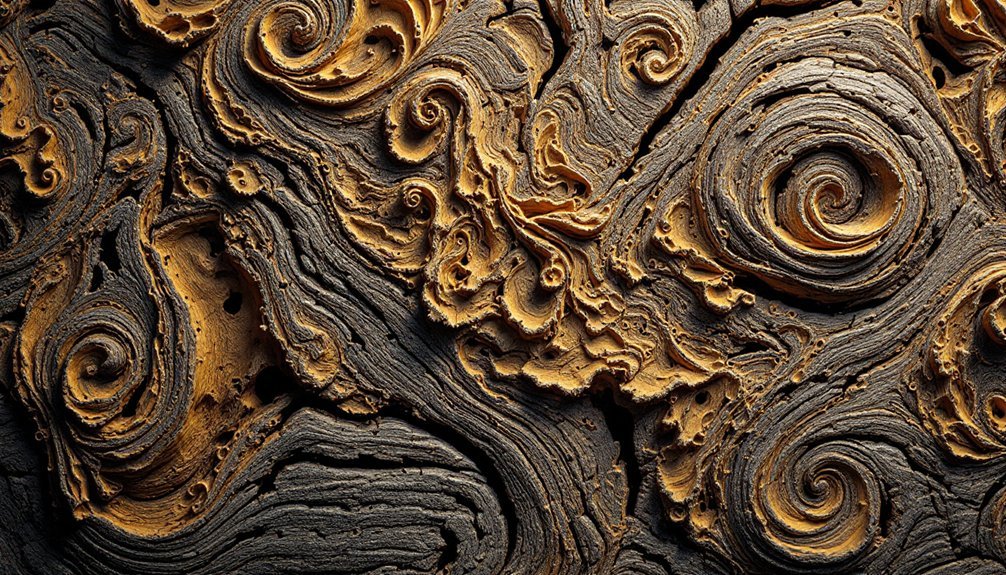



Leave a Reply